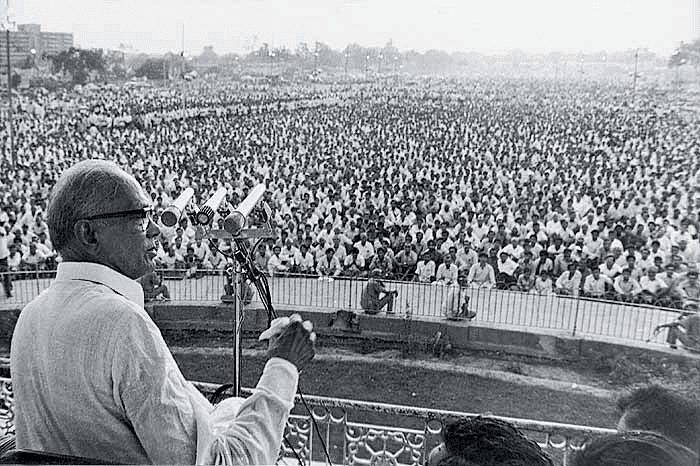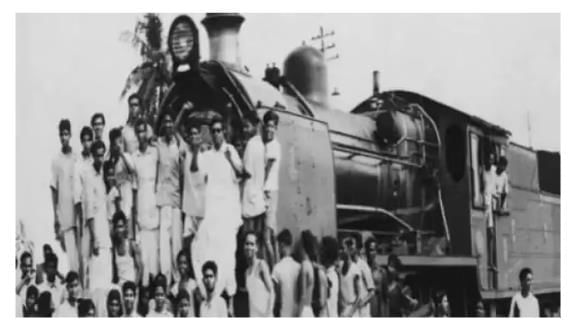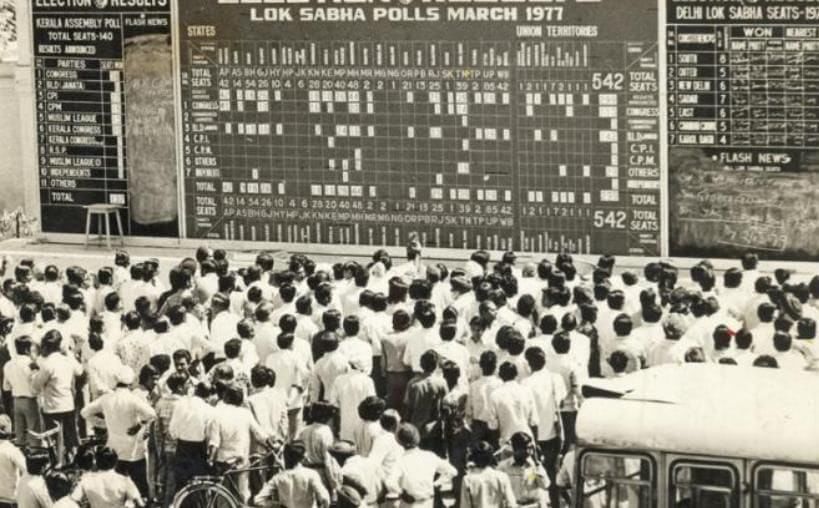The Crisis of Democratic Order Class 12 Political Science
| Table of contents |

|
| Introduction |

|
| Declaration of Emergency |

|
| Controversies regarding Emergency |

|
| Politics after Emergency |

|
| Legacy |

|
Introduction
"The Crisis of Democratic Order" refers to a period in Indian history marked by significant challenges to the country's democratic institutions and principles. This term is often associated with the period of the 1970s when India faced internal political turmoil, culminating in the imposition of Emergency Rule by Prime Minister Indira Gandhi from 1975 to 1977.
Background to Emergency
- 1970’s were a period of political turmoil in India. This period witnessed tensions in relations between the government and the judiciary.
- Ideological differences erupted within the Congress and it sharpened the division between Indira Gandhi and her opponents.
Economic Context
- India’s economy suffered due to the Bangladesh war.
- Approximately 8 million refugees entered India, which put pressure on the Indian economy.
- The U.S. government halted all aid to India following the Bangladesh crisis.
- Economic growth slowed.
- Oil prices increased in the international market, due to which inflation in the country increased.
- Unemployment increased.
- To cut costs, the government froze the salaries of its employees.
Gujarat and Bihar Movements
- Gujarat and Bihar were Congress-ruled states. Despite this fact, students from both states started agitation against rising prices of food grains, cooking oil and other essential commodities, and against corruption in high places.
- Jai Prakash Narayan from Bihar called for total revolution in the social, economic and political spheres.
- In 1975, Jai Prakash led one of the largest marches to the Parliament.
 Jai Prakash in 1975 rally
Jai Prakash in 1975 rally
The Naxalite Movement
- During this time, some Marxist people who did not believe in parliamentary politics also started coming forward.
- These people wanted to end the political system and the capitalist system.
- To end this system, they adopted the path of violence and resorted to guerrilla warfare.
- These people were called Naxalites.
- They snatched the land by force from the rich landlords and started giving it to the poor farmers.
- Violence was committed by these people at many places in the country.
Railway Strike of 1974
- In May 1974, the National Coordination Committee for Railwaymen's Struggle, led by George Fernandes, called for a nationwide strike by all railway employees to demand better bonuses and service conditions.
- This strike caused major disruptions, as the country's economy heavily relied on trains for transporting goods.
- The government opposed these demands, declaring the strike illegal and arresting many of the leaders involved.
- The strike added to the existing atmosphere of labour unrest.
- As the government refused to meet the workers' demands, the strike was called off after twenty days without any resolution.
 Railway Strike,1974
Railway Strike,1974
Conflict with the Judiciary
During this time, the government and the ruling party had many arguments with the judiciary (courts).
Three main constitutional questions emerged :
i)Can Parliament limit Fundamental Rights?
The Supreme Court said no, Parliament cannot do that.
ii) Can Parliament reduce the right to property by changing the Constitution?
The Court again said no, such a change is not allowed.
iii) Parliament changed the Constitution to say that it could limit Fundamental Rights to follow Directive Principles.
The Supreme Court rejected this change too.
These issues led to a serious conflict:
i) All these arguments created a crisis between the government and the judiciary.
ii) This conflict reached its peak in the Kesavananda Bharati case.
iii) In this case, the Supreme Court said that Parliament can change the Constitution, but it cannot change its basic structure.
The conflict grew stronger after two major events:
i) In 1973, a new Chief Justice of India needed to be appointed after the Court's decision.
ii)Usually, the most senior judge was made Chief Justice.
iii) This time, the government ignored three senior judges (JM Shelat, KS Hegde and AN Grover) and made AN Ray the Chief Justice of India
iv) The three judges who were ignored were the same judges who gave the verdict against the government.
v)Due to all these reasons, the conflict between the government and the judiciary increased further.
Declaration of Emergency
On 12th June, 1975, Justice Jagmohan Lal Sinha of the Allahabad High Court declared Indira Gandhi’s election to the Lok Sabha invalid. This decision created a political crisis.
Crisis and Response
- Due to the fast-changing political climate and the JP Movement, the government advised the imposition of emergency on 25th June 1975 to President Fakhruddin Ali Ahmed. The Prime Minister made this recommendation that night, leading to an immediate proclamation.
- The emergency was declared under Article 352 of the Constitution, which permits a state of emergency based on external threats or internal disturbances. During an emergency, normal federal power distribution is largely suspended, centralising authority with the union government.
- The Cabinet was notified during a special meeting at 6 am on 26th June, 1975.
- After midnight, power was cut to major newspaper offices, and many opposition leaders and activists were arrested early in the morning.
Consequences
- Freedom of the Press and several Fundamental Rights of citizens were suspended, including their ability to approach the Court to restore these rights. All protests ceased; strikes were prohibited; opposition leaders were imprisoned.
- This led to an immediate halt of the unrest; strikes were forbidden, and many opposition leaders were jailed, creating a quiet but tense political climate. The government frequently used preventive detention, arresting individuals based on the fear that they might commit an offence, rather than for any actual wrongdoing.
- Following the Allahabad High Court ruling in the Indira Gandhi case, an amendment was introduced stating that the elections of the Prime Minister, President, and Vice-President could not be contested in Court.
- Newspapers were required to obtain prior approval for all content before publication, a practice known as press censorship.
- Due to concerns over social and communal unrest, the government banned the Rashtriya Swayamsevak Sangh (RSS) and Jamaat-e-Islami, and prohibited protests and public demonstrations.
- The Emergency concluded as dramatically as it began, resulting in the Congress party's defeat in the 1977 Lok Sabha elections.
Controversies regarding Emergency
Why was Emergency Necessary?
- The political atmosphere in the country had turned sharply against the Congress party.
- Opposition parties, led by Jayaprakash Narayan, demanded Indira Gandhi's resignation and organised a large protest.
- This protest was quickly suppressed; strikes were prohibited; many opposition leaders were imprisoned, leading to a calm yet tense political climate.
- The government announced that there was a risk of internal unrest.
- They concluded that a serious crisis had emerged, necessitating the declaration of a state of emergency.
The government also invoked Article 352 of the Constitution, which permits declaring a state of emergency if there is a threat to the security of India or any part of it.
The Emergency had major effects, such as the suspension of Fundamental Rights and the centralisation of power within the union government. Furthermore, the government curtailed the freedom of the Press and introduced press censorship, requiring newspapers to secure prior approval for all published content.
What happened during the Emergency?
- The Emergency was declared in 1975 due to fears of internal unrest, which the government claimed was necessary to keep order and stability in the nation.
- Following the Emergency, an investigation by the Shah Commission revealed that excessive restrictions were enforced in certain areas.
- The government argued that in a democracy, the opposition parties should permit the elected ruling party to implement its policies, especially during a crisis.
- Critics contend that Indira Gandhi exploited constitutional measures meant for national security to strengthen her personal authority, especially by declaring the Emergency.
- The Shah Commission estimated that around 100,000 individuals were detained under preventive detention laws, underscoring the extent of governmental actions during this time.
- In addition to the arrests of political workers and press censorship, the Emergency significantly impacted the daily lives of ordinary citizens, many of whom faced curfews and loss of civil liberties.
- The long-term effects of the Emergency on Indian democracy included heightened public awareness of civil liberties and the eventual restoration of democratic processes, alongside reforms in the constitutional provisions related to declaring emergencies.
Lessons from Emergency
- It is very hard to eliminate democracy in India.
- ‘Internal’ emergency can only be declared on the basis of ‘armed rebellion’, and the President must receive written advice from the Union Cabinet to declare it.
- The Emergency raised awareness about the importance of civil liberties. The Courts have also become more active in safeguarding these rights after the Emergency.
- The most important lesson from the Emergency was evident as soon as it ended and the Lok Sabha elections were called.
- The opposition campaigned with the slogan of 'save democracy'.
- The public's decision was clearly against the Emergency.
- The lesson was clear: governments seen as anti-democratic face severe consequences from voters, a trend observed in many subsequent state elections.
- Thus, the experience from 1975-77 actually reinforced the principles of democracy in India.
Politics after Emergency
The experience of the emergency was quite visible in the 1977 Lok Sabha Elections. The people’s verdict was decisively against the emergency.
Lok Sabha Elections, 1977
- The Janata Party turned this election into a vote on the Emergency. Their campaign highlighted the undemocratic nature of the government and the various abuses that occurred during this time.
- With thousands arrested and the Press under strict control, public sentiment shifted against the Congress. Jayaprakash Narayan emerged as a popular figure symbolising the fight for democracy.
- For the first time since Independence, the Congress Party lost in the Lok Sabha elections.
- The Congress secured only 154 seats, with their share of votes dropping to below 35 per cent. The Janata Party and its allies won a total of 330 out of 542 seats; the Janata Party itself gained 295 seats, achieving a clear majority.
- In north India, there was a significant backlash against the Congress. They lost in every constituency in Bihar, Uttar Pradesh, Delhi, Haryana, and Punjab, managing to win just one seat in Rajasthan and Madhya Pradesh. Indira Gandhi was defeated in Rae Bareli, as was her son Sanjay Gandhi in Amethi.
 Historic 1977 Lok Sabha elections
Historic 1977 Lok Sabha elections
Janata Government
- Following the 1977 election, there was intense competition among three leaders for the role of Prime Minister Morarji Desai, Charan Singh, and Jagjivan Ram. Ultimately, Morarji Desai took on the role.
- The Janata Party split, and a new government led by Charan Singh was established with the support of the Congress Party. However, the Congress Party later withdrew its support, leading to the Charan Singh government lasting only about 4 months.
- The government under Morarji Desai lost its majority in less than 28 months.
- Fresh Lok Sabha elections occurred in January 1980, where the Janata Party faced a significant defeat, especially in north India, where it had previously performed well in 1977.
- The Janata Party framed this election as a referendum on the Emergency, focusing on the non-democratic nature and various excesses during that time.
Legacy
Congress Transformed
- Before 1969, Congress was an inclusive party with leaders from different ideologies.
- By the early 1970s, it was identified as a socialist and pro-poor party, relying on Indira Gandhi’s charisma.
- Political success now depended on dividing voters along ideological and social lines.
Rise of ‘Non-Congressism’
- Opposition parties united to prevent a split in the anti-Congress vote.
- This strategy led to Congress’s defeat in the 1977 elections, reshaping Indian politics.
Backward Castes Gained Political Influence
- The 1977 elections saw backward castes in North India shifting away from Congress.
- Non-Congress state governments emerged, with backward caste leaders playing key roles.
- The demand for OBC reservations led to the formation of the Mandal Commission by the Janata government.
The Emergency: A Double Crisis
- Constitutional Crisis: It was rooted in a power struggle between Parliament and the judiciary.
- Political Crisis: Despite a strong majority, the Congress government suspended democracy.
- The Constitution had granted emergency powers, assuming they would be used responsibly, but they were misused.
Mass Protests vs. Institutional Democracy
- A key question arose: Should democracy rely only on elections or also on public protests?
- The inability of political parties to reflect people’s aspirations led to growing mass movements.
- This struggle between formal institutions and popular protests shaped future political debates, including those on regional identity.
This period marked a major shift in Indian politics, setting the stage for new political alliances, caste-based movements, and debates on democracy.
|
34 videos|308 docs|51 tests
|
FAQs on The Crisis of Democratic Order Class 12 Political Science
| 1. What is meant by the term "Crisis of Democratic Order"? |  |
| 2. What triggers a Declaration of Emergency in a democratic country? |  |
| 3. What are the controversies surrounding the imposition of Emergency? |  |
| 4. How does politics change after the lifting of Emergency? |  |
| 5. What lessons can be learned from periods of Emergency in democratic societies? |  |
















